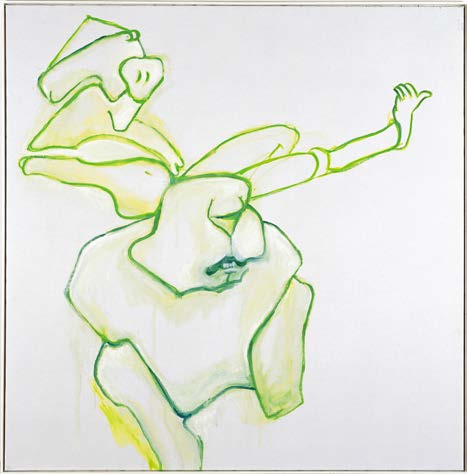A new survey exhibition of painting by Maria Lassnig, at Hauser & Wirth, spanning a period from the 1950s to the end of the artist’s life opens in early March.The show traces Lassnig’s evolution from early experiments with abstraction to a richly inventive figuration and the refinement of her ‘body awareness’ paintings, in which she captured physical sensation as felt from within. Lassnig devoted much of her career to recording her physiological states through a direct and unflinching style, believing that ‘truth resides in the emotions produced within the physical shell’. Pursuing her extraordinary science of the self, Lassnig rendered an oeuvre that has influenced important artists such as Martin Kippenberger and Paul McCarthy. The presentation is a re-imagining of the exhibition staged at Hauser Wirth & Schimmel, Los Angeles, in 2016. It has been organised by Peter Pakesch, Chairman of the Maria Lassnig Foundation, Vienna, and Paul Schimmel, Vice President, and Partner, Hauser & Wirth.
‘Maria Lassnig. A Painting Survey, 1950 – 2007’ reveals the ways in which the artist drew from and challenged conventions of abstraction to create a singular figuration. Organised chronologically, the exhibition unfolds across two gallery spaces, beginning with the early 1950s. In rarely seen oil paintings such as the 1953 works ‘Flächenteilung Schwarz-Weiss-Grau 2’ (Field-division black-white-grey 2) and ‘Flächenteilung Schwarz-Weiss- Grau 1’ (Field-division black-white-grey 1), viewers can see Lassnig exploring an abstract visual language bolstered by her immersion in the Vienna Art Club, French avant-garde circles and her relationships with writers including Paul Celan, Friederike Mayröcker and Oswald Wiener.
In 2013 Lassnig was awarded the Golden Lion for Lifetime Achievement
By the late 1950s and early 1960s, Lassnig’s work had turned to gestural, field-like abstract landscapes, exemplified by ‘Tachismus 4’ (Tachism 4) (1958 / 1959) and ‘Ohne Titel’ (Untitled) (ca. 1960), in which her earlier subdued palette is replaced by intense, warm colour. At the same time, an innovative figuration, expressive and painterly, is beginning to emerge. In canvases such as ‘Selbstporträt als Tier’ (Self-portrait as animal) (1963) and ‘Balancing Myself’ (1965), Lassnig trains her eye upon herself, resulting in works that are caricatured, allegorical and psychologically penetrating. Her intense colour palette in this period, with hot pinks and florid purples and reds, is deliberately unnatural, provoking a re-evaluation of the figure-ground relationship.
In the 1970s, Lassnig turned to a subtle, cooler, but equally surreal palette to portray recognisable nude figures, including the two self-portraits on view, ‘Dreifaches Selbstporträt / New Self’ (Triple Self-portrait / New Self) (1972) and ‘Selbstporträt mit Weinglas’ (Self-portrait with wine glass) (1975). These depictions of solitude give way in the 1980s to figures barely recognisable as human, but whose raw vulnerability instantly denotes Lassnig’s hand. By the end of the decade, the artist’s ongoing exploration of figure-ground tensions is expressed in works such as ‘Große Flächenteilung / Spiegel’ (Large field-division / mirror) (1989) and ‘Unterbrechung’ (Interruption) (1989), in which simple shapes are painted over horizontal swaths of intense and even acrid contrasting colour fields.
The artist’s work from the 1990s and 2000s shifted from an agitated, intense palette to cool, vivid, and complementary hues. Fragmented figures in some works – ‘Generationsfußtritt / Generationsprobleme II’ (Generational kick / Generation problems II) (1998 / 1999) and ‘Be-Ziehungen VI’ (Re-lations VI) (1994), for example – seem to suggest the artist confronting questions of knowledge, language and generational conflict. Other canvases on view, painted in this final period of Lassnig’s life, reflect tender and personal moments – a figure kissing a teddy bear, a self-portrait blowing a bubble.

Born in Carinthia in southern Austria, Maria Lassnig (1919 – 2014) studied at the Academy of Fine Arts in Vienna in the midst of the Second World War, beginning in the Winter term 1940 and graduating in 1945. In post-war Europe, she quickly moved away from the state-approved academic realism in which she had been trained, turning to Austria’s own avant-garde past and finding inspiration in the colouration of Oskar Kokoschka and the expressionist figuration of Egon Schiele. She continued to develop her painting practice, moving between Vienna and Paris, where she lived from 1961 to 1968. In 1968, Lassnig moved to New York, where she worked in various studios, first in Queens, then in the East Village from 1969 and in SoHo from 1974 to 1978. In 1978, she received a scholarship from the German Academic Exchange Service (DAAD) and went for a year to Berlin. In 1979, Lassnig returned to New York, where she inhabited an apartment on First Avenue. Lassnig’s New York era brought significant artistic growth. She created pioneering work in film, producing a series of remarkably inventive animations, before she returned to Austria in 1980 at the age of 60.
In 1980, Lassnig was awarded a professorship – with a focus on painting – at the University of Applied Arts in Vienna. From 1980 to 1989, Lassnig held the master class for ‘Gestaltungslehre – experimentelles Gestalten’ (Design Theory – experimental design). In addition to painting, she also taught animated film. Also in 1980, Lassnig represented Austria in the 39th Venice Biennale and then went on to participate in documenta VII (1982) and documenta X (1997). Her 2014 solo exhibition at MoMA PS1, Long Island City NY, was the first major US show of the artist’s work. Lassnig’s work has been the subject of many well- attended international solo exhibitions, including surveys at the Stedelijk Museum, Amsterdam, Netherlands (1994); Centre Georges Pompidou, Paris, France (1995); Serpentine Gallery, London, England (2008); and Tate Liverpool, Liverpool, England (2016).
In 2013 Lassnig was awarded the Golden Lion for Lifetime Achievement.
Copyright and Courtesy Credits: Maria Lassnig Dreifaches Selbstporträt / New Self (Triple Self-Portrait / New Self) 1972 Maria Lassnig Der irdische Wettlauf (The Earthly Race) 1963 Maria Lassnig Frau und Mann (Woman and Man) 2007 All images: © Maria Lassnig Foundation Courtesy the Foundation and Hauser & Wirth
